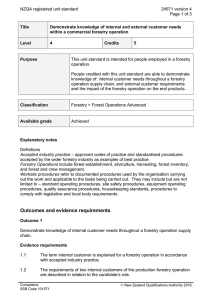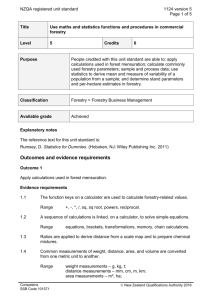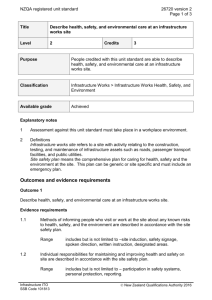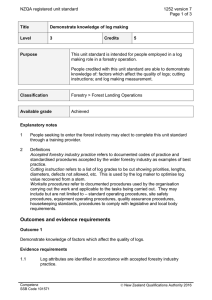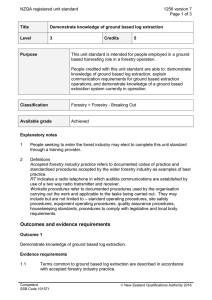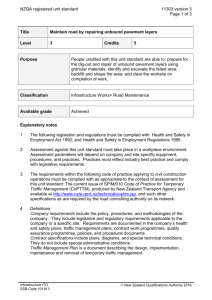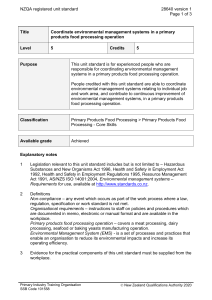17758 Plan and form an extraction track in a forestry operation
advertisement
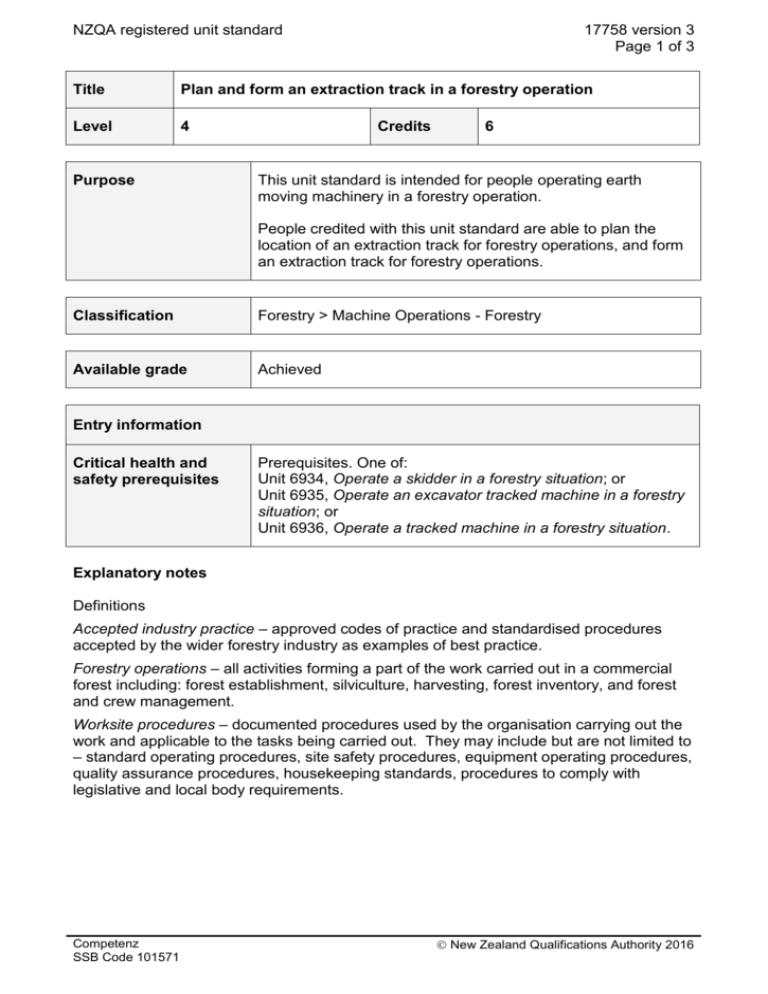
NZQA registered unit standard 17758 version 3 Page 1 of 3 Title Plan and form an extraction track in a forestry operation Level 4 Purpose Credits 6 This unit standard is intended for people operating earth moving machinery in a forestry operation. People credited with this unit standard are able to plan the location of an extraction track for forestry operations, and form an extraction track for forestry operations. Classification Forestry > Machine Operations - Forestry Available grade Achieved Entry information Critical health and safety prerequisites Prerequisites. One of: Unit 6934, Operate a skidder in a forestry situation; or Unit 6935, Operate an excavator tracked machine in a forestry situation; or Unit 6936, Operate a tracked machine in a forestry situation. Explanatory notes Definitions Accepted industry practice – approved codes of practice and standardised procedures accepted by the wider forestry industry as examples of best practice. Forestry operations – all activities forming a part of the work carried out in a commercial forest including: forest establishment, silviculture, harvesting, forest inventory, and forest and crew management. Worksite procedures – documented procedures used by the organisation carrying out the work and applicable to the tasks being carried out. They may include but are not limited to – standard operating procedures, site safety procedures, equipment operating procedures, quality assurance procedures, housekeeping standards, procedures to comply with legislative and local body requirements. Competenz SSB Code 101571 New Zealand Qualifications Authority 2016 NZQA registered unit standard 17758 version 3 Page 2 of 3 Outcomes and evidence requirements Outcome 1 Plan the location of an extraction track for forestry operations. Evidence requirements 1.1 Planning and location of extraction track is compatible with environmental requirements, job prescription, and operational requirements. Range regional authority requirements, forest owner requirements, riparian protection areas. 1.2 Cut-offs, soak holes, and water-tables are planned as required to minimise channelling of water runoff, in accordance with the job prescription and accepted industry practice. 1.3 Machinery selected is suitable for track formation in accordance with accepted industry practice. Range 1.4 Hazards associated with track formation are described and control methods explained in accordance with accepted industry practice. Range 1.5 includes but is not limited to – overhang, falling debris, subsidence, rolling stumps, rocks, unstable trees, soft ground conditions, undermining root plates, nearby forestry operations. Factors to be considered when pushing over standing trees are explained in accordance with accepted industry practice. Range 1.6 type, size, power, stability, protective equipment. machine type and size, technique and machine placement, minimising stem damage, two tree length rule. Obstructions on the site which require removal are explained in accordance with accepted industry practice. Range stumps, rock outcrops, fallen trees. Outcome 2 Form an extraction track for forestry operations. Evidence requirements 2.1 Obstructions are removed with minimal stress and damage to machine in accordance with accepted industry practice. Range Competenz SSB Code 101571 shock loading, hydraulic overload, blade or bucket damage. New Zealand Qualifications Authority 2016 NZQA registered unit standard 2.2 Obstructions are managed to minimise hazards during future operations. may include but is not limited to – stability, placement. Range 2.3 Extraction tracks are formed to meet operational and environmental requirements. Range 2.4 17758 version 3 Page 3 of 3 manageable gradients, stable formation, inward sloping, minimal visual impact, minimal soil disturbance, residual tree stability. Hazards are identified and managed in accordance with accepted industry practice. Planned review date 31 December 2020 Status information and last date for assessment for superseded versions Process Version Date Last Date for Assessment Registration 1 5 December 2000 N/A Review 2 22 May 2008 31 December 2017 Review 3 10 December 2015 N/A Consent and Moderation Requirements (CMR) reference 0173 This CMR can be accessed at http://www.nzqa.govt.nz/framework/search/index.do. Please note Providers must be granted consent to assess against standards (accredited) by NZQA, before they can report credits from assessment against unit standards or deliver courses of study leading to that assessment. Industry Training Organisations must be granted consent to assess against standards by NZQA before they can register credits from assessment against unit standards. Providers and Industry Training Organisations, which have been granted consent and which are assessing against unit standards must engage with the moderation system that applies to those standards. Requirements for consent to assess and an outline of the moderation system that applies to this standard are outlined in the Consent and Moderation Requirements (CMR). The CMR also includes useful information about special requirements for organisations wishing to develop education and training programmes, such as minimum qualifications for tutors and assessors, and special resource requirements. Comments on this unit standard Please contact Competenz at qualifications@competenz.org.nz if you wish to suggest changes to the content of this unit standard. Competenz SSB Code 101571 New Zealand Qualifications Authority 2016
